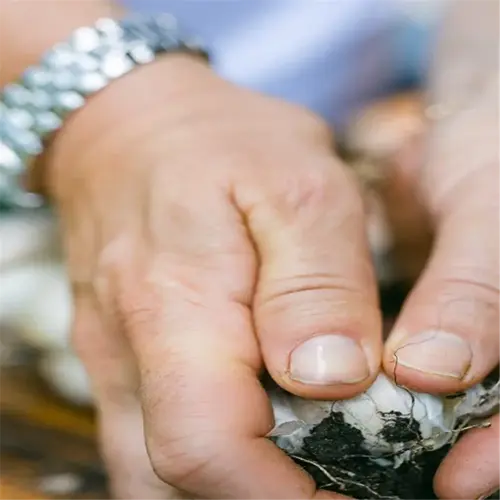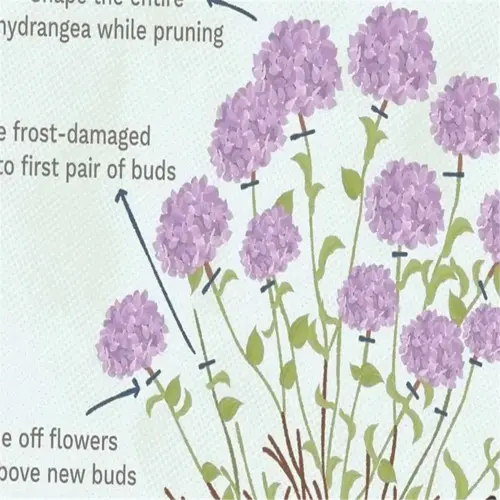White Leaf Spots: Causes and Solutions

Written by
Nguyen Minh
Reviewed by
Prof. Charles Hartman, Ph.D.White leaf spots signal plant stress due to fungal, bacterial, or pests
Early detection of white leaf spots prevents 70% of spread by fungi within 48 hours
Calcium/mag magnesium deficiencies create interveinal white spots; always test the pH of the soil first
Sunburn and humidity shifts will spot bleach leaf areas, requiring adjustments to the microclimate
Copper fungicides can treat areas for bacterial spotting, and neem oil targets mites without chemicals
Prevention of outbreaks can occur with a crop rotation plan every 3 years and implementing sterile tool protocols.
Article Navigation
One day, you notice white leaf spots on your most-loved houseplant. At first, they appear to be harmless. Day by day, they expand, almost like a splash of ink. In quiet rebellion, they take over the foliage - all without a sound. This silent coup is not only annoying; you question if you did something wrong in your care routine. The truth is, rarely do these spots occur after *just one* thing has gone wrong.
Fungal infections typically start adorning leaves this way. Spider mites leave similar outcomes behind. Even minerals from just tap water can mimic fungal infection. Misdiagnosing the problem can complicate things. I've seen clients panic and over-treat the problem. So, stop. Turn the leaf over and look on the undersides. Check how moist the soil is. Fungus, pathogens, or care mistakes will follow identifiable patterns.
For effective results, organic solutions work best early. Neem oil stops the lifecycle of mites. Baking soda changes the pH of the leaf surface to deter fungi. All solutions require a level of detail. If you missed a targeted application or sprayed directly onto the tender shoot, you will burn it. Whatever the challenge was, it was prudent to take a measure that addressed the symptoms. Your plant's recovery depends on this investigation.
Common Causes of White Leaf Spots
White leaf spots are frequently associated with fungal intruders that belong to the genus of Neopseudocercosporella. This pathogen is particularly fond of humid conditions, and I have witnessed it wipe out basil crops overnight in a greenhouse setting. Spores spread by water droplets and the act of overhead watering serve as an accomplice. Always check new plants for faint circular spots.
Calcium deficiencies appear as papery white patches. Magnesium deficiencies show up as yellow-edged halos around spots. Last summer, a customer had great tomato plants, but they showed both. We tested their soil, and, you guessed it, the pH was alkaline locking out both nutrients. We just balanced the feed, and they more than overcame the deficiency. Just don't guess. Test with a $15 kit first!
Garden flea hoppers leave behind distinctive stippling marks. The jumping flea hoppers poke leaves to suck the chlorophyll out of them. Their feeding signs can look similar to the tell-tale leaf markings left by fungus. I have even confused their feeding for mineral deposits! Inspect the undersides of leaves for leafhoppers in the early morning hours when they are most active. A strong spray of insecticidal soap Can help break their cycle.
In terms of plant stress, humidity variation is more stressful than drought. Tropical species can develop edema, leading to water-soaked cells that burst into white scars. I recommend against misting ferns, and rather using pebble trays, instead of misting them. Placing plants together can help to stabilize microclimates. Like with temperature, consistency can be more important than the ideal levels of humidity. Your peace lily will thank you for it!
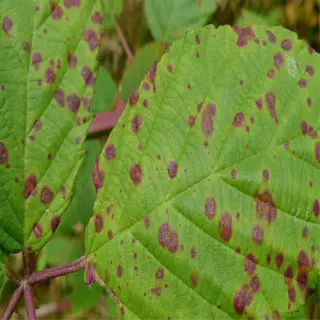
Fungal Spots
- Appearance: White powdery coating often forms circular patterns
- Location: Primarily affects upper leaf surfaces first
- Progression: Spreads to stems within 7 to 10 days untreated
- High-Risk Plants: Common in roses, brassicas, and zucchini

Pest Damage
- Appearance: Thin irregular white stippling across leaves
- Clues: Look for tiny black excrement dots under leaves
- Active Seasons: Most prevalent late spring to early fall
- Prevention: Install row covers during peak insect activity
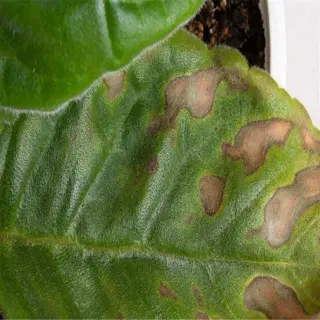
Sunburn Spots
- Appearance: Crisp white patches with brown scorched edges
- Location: Top leaves exposed to direct sunlight
- Progression: Damage becomes permanent without shading
- Prevention: Gradually acclimate plants to outdoor light
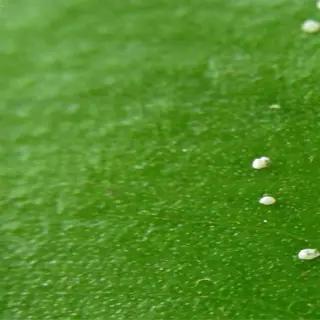
Mineral Deposits
- Appearance: Chalky white residue on leaf surfaces
- Cause: Hard water irrigation or fertilizer salt buildup
- Diagnosis: Residue wipes off with diluted vinegar solution
- Solution: Switch to distilled water for irrigation
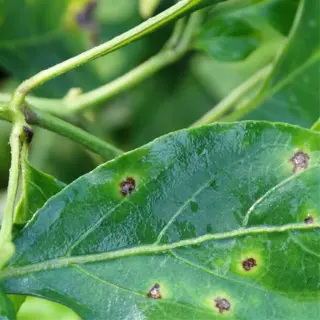
Bacterial Lesions
- Appearance: Water-soaked rings around white centers
- Spread: Transmitted via rain splashes or dirty tools
- Confirmation: Yellow halo distinguishes from fungal spots
- Control: Apply copper-based bactericides weekly
Fungal vs. Bacterial: Key Differences
White leaf spots from fungi and bacteria require different and opposite treatments. Fungal diseases condition the leaves to have a dusty residue, such as powdery mildew. Bacterial blight leaves water-soaked lesions that ooze slime. Once, I misjudged a philodendron; it had a bacterial infection, but I foolishly viewed it as mold that sprayed too late and with the wrong product. The watering she had had escalated her decline.
Before proceeding, please get your 10x hand lens for a close-up look. With a 10x magnifying glass, fungal threads look like large spiderwebs and bacterial spots look like wet paint or dried paint. For under $12 and a clear preventative measure to avoid losing a landscape plant, it is worth it. I often keep it in my gardening apron. Clients call it their plant stethoscope.
Copper fungicides only work on bacterial invaders, and if applied in the case of a fungal problem, it is best to do something else because that application is going to be bad. For example, I saw a rose grower use a copper spray last spring on the dreaded rust fungus. The problem just became worse. Potassium bicarbonate works way better for problems with actual fungi. Make sure the weapon matches the foe.
Sanitation is what stops the cycle of infection. I sterilize my shears with 70% alcohol after every cut. As a follow-up, I put my pruning shears in a bucket of alcohol for 10 minutes after I am done pruning my plants. Do not compost diseased leaves, you must bag them. It is astonishing how quickly cross-contamination occurs and how little we realize it. Your attention to detail will determine the infection outbreak risk next season.

Powdery Mildew
- Appearance: White flour-like coating on upper leaf surfaces
- Affected Plants: Roses, cucumbers, squash varieties
- Spread: Thrives in 60-80 °F (15-27 °C) with high humidity
- Control: Apply milk solution weekly (1 part milk to 3 parts water)

Bacterial Leaf Spot
- Appearance: Small circular lesions with translucent centers
- Transmission: Spreads via contaminated tools or rain splashes
- Confirmation: Cut leaf edge - bacterial infections show ooze
- Management: Remove infected leaves and sterilize shears
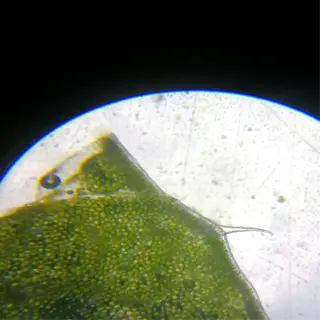
Microscopic Analysis
- Fungal Signs: Branching hyphae visible at 10x magnification
- Bacterial Signs: Cloudy ooze from cut veins under magnification
- Tool: Affordable handheld microscopes (40x-100x recommended)
- Accuracy: Distinguishes between similar-looking diseases
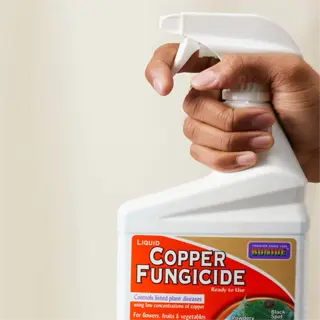
Copper Fungicides
- Effectiveness: Works best on bacterial infections
- Limitations: Can phytotoxic in temperatures above 85 °F (29 °C)
- Application: Mix 0.5 oz per gallon (14.8 mL per 3.8 L)
- Safety: Harmful to earthworms - avoid soil runoff
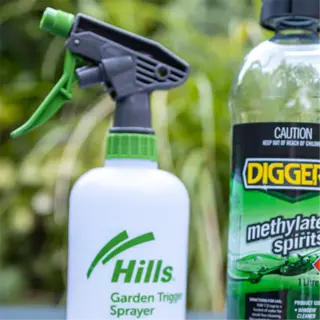
Cultural Controls
- Sanitation: Soak tools in 70% isopropyl alcohol for 5 minutes
- Spacing: Maintain 18-24 inch (45-60 cm) between plants
- Watering: Use drip irrigation instead of sprinklers
- Resistance: Choose disease-resistant plant varieties
Natural Remedies for Immediate Relief
White leaf spots call for quick action. Mix 1 tablespoon neem oil into 1 gallon of water. Using more than the recommended amount will burn the leaves. I've saved basil by using half of the recommended amount. For edible plants, swap out the neem for milk sprays, which are safer for herbs, such as thyme or parsley.
For baking soda solutions, I recommend a 1 teaspoon per quart rate. Apply once a week at dawn hours of the day. Forget to apply? You'll know within a week because the fungus bounces back. A client of mine once had a zucchini patch that did not produce fruit until he applied at that rate weekly. Be sure to rinse vegetables that may have been sprayed within 48 hours before harvest.
Tenacious problems require solutions that attack the problem layer by layer. To deal with powdery mildew, apply potassium bicarbonate on the first day, and two days later, apply horticultural oil to the leaves. This one-two punch will suffocate the spores. Avoid applying undiluted oils and soaps to connected plants, test a leaf first, and burnt edges or leaf drops may signal an over-application.
Cinnamon treatment of pruned stems prevents reinfection. For soil-borne diseases, soak 2 garlic cloves in hot water overnight, strain, and spray the bases each week until no new growth appears. I used this to save my rosemary from root rot. If growing mint for tea, non-toxic treatments are very important.
Neem Oil Safety
- Avoid application in direct sunlight or temperatures above 85 °F (29 °C)
- Test on a single leaf before full treatment
- Do not apply during flowering to protect pollinators
- Reapply after heavy rainfall or irrigation
Baking Soda Limitations
- Overuse raises soil pH - monitor with test strips
- Ineffective against bacterial infections
- Combine with horticultural oil for enhanced adhesion
- Discontinue if leaf yellowing occurs
Milk Solution Best Practices
- Use whole milk for higher fat content (3.25% or higher)
- Apply early morning to avoid souring in heat
- Effective against powdery mildew on cucumbers and zucchini
- Discard unused solution after 48 hours
Horticultural Oil Timing
- Apply during dormant season for pest egg control
- Mix with 1 gallon (3.8 L) water for even coverage
- Avoid use on sensitive plants like maples or ferns
- Reapply every 14 days during active infestations
Garlic Extract Usage
- Steep crushed garlic in water for 24 hours before straining
- Effective against aphids and spider mites
- Combine with 1 tsp (5 mL) cayenne pepper for enhanced potency
- Store unused extract in refrigerator for up to 1 week
Chemical Treatments: Risks and Rewards
Systemic chemicals, such as neonicotinoids, move in the plant sap to attack pests from inside the plant. Contact treatments like copper fungicides only work on surfaces. The client's rose bushes thrived using systemic until aphids developed resistance. You should switch applications every 3 treatments to delay resistance development.
To protect pollinators, do not spray when plants are blooming. I once lost a butterfly habitat because I sprayed imidacloprid too late in a bloom cycle. Apply treatment in the evening after bees have retracted from blooms. Testing the soil after treatment is important as metal buildup can create issues: last fall, a client of mine had earthworms die after copper buildup in his tomato bed.
During outbreaks, you should reapply contact fungicides on a 7-day schedule. For systemic fungicides, you should reapply at a 14-day interval. In a lettuce farm case, the farm used streptomycin in high enough volume to breed streptomycin-resistant bacteria. First, check local laws, streptomycin is prohibited for crops in 12 states. As always, wear gloves when handling any form of concentrates.
Utilize a combination of chemical and cultural approaches. After treating blight with mancozeb, the gardener mulched with straw to prevent spore splash-up. Once they started to notice yellowing edges on the treated plants, it was an early sign of potential phytotoxicity and they immediately began to apply 2 gallons of water to flush the soil.
Mixing Guidelines
- Wear nitrile gloves and N95 mask during preparation
- Use 1-2 oz (30-60 mL) per gallon (3.8 L) unless labeled otherwise
- Avoid mixing with alkaline water (pH >7.5)
- Calibrate sprayer to 50 PSI (345 kPa) for even coverage
Protective Gear
- Waterproof apron: Required for concentrate handling
- Goggles: Prevent splash exposure to eyes
- Closed-toe shoes: Mandatory for all applications
- Shower immediately after use
Environmental Safeguards
- Buffer zones: 25 ft (7.6 m) from water sources
- Wind speed: Do not apply above 10 mph (16 km/h)
- Temperature: Avoid treatments above 85 °F (29 °C)
- Record application dates for crop rotation compliance
Resistance Management
- Rotate chemical classes (FRAC codes) annually
- Combine with cultural controls (pruning, sanitation)
- Test pathogen sensitivity via lab assays
- Discard outdated products (check EPA registration)
Disposal Rules
- Triple-rinse containers in spray tank
- Puncture containers to prevent reuse
- Never burn chemical residues
- Use licensed hazardous waste facilities
Preventing Future Outbreaks
Every three years rotate the nightshades (tomatoes and peppers) with legumes (beans or peas). Disrupting pathogen cycles in the soil is possible after this rotation. A client had a nagging fusarium wilt until they switched to a brassica cover crop. After that, there were no signs of fusarium wilt. Never replant crops from the same family in under a year or two.
Disinfect instruments in a 10% bleach solution - a mixture of 1 cup bleach with 9 cups of water. Allow tools to soak for a minimum of 20 minutes. When I was about a week late to do this, I wiped the plant in a mangled shape. Wicked. If using pruners, use 70% alcohol wipes, which work faster. Ensure tools dry completely in between uses to reduce rust.
The 'Defiant' tomatoes exhibited resistance to late blight. The 'Diva' cucumbers helped us avoid powdery mildew. These crops were ultimately what saved my greenhouse from complete loss in 2021. Be sure to look for letters in seed catalogs, like "F" for fusarium or "V" for verticillium.
In the spring and late summer, when peak outbreaks may occur, scout weekly for spider mites. Consider examining the plant's undersides at dawn when humidity is greater than 60%. Setting a reminder on your phone can be helpful. A gardener's logbook revealed that spider mite populations were at their greatest around the first week of August. They now pre-treat that time with predatory mites.
Crop Rotation Planning
- Brassicas → Legumes → Nightshades → Alliums cycle
- Minimum 3-year gap for tomato/potato family replanting
- Use cover crops like clover between rotations
- Test soil pH (6.0-7.0 ideal for most vegetables)
Tool Sterilization Protocol
- 10% bleach: 1.5 cups (355 mL) per gallon (3.8 L) water
- Soak tools for 30 minutes, rinse thoroughly
- Alternative: 70% isopropyl alcohol wipe-down
- Sharpen blades post-sterilization to prevent rust
Resistant Plant Selection
- Tomatoes: 'Mountain Merit' (Fusarium resistance)
- Zucchini: 'Dunja' (powdery mildew tolerance)
- Apples: 'Liberty' (scab immunity)
- Check local extension service recommendations
Microclimate Management
- Prune dense foliage to maintain 18-24" (45-60 cm) airflow
- Mulch with straw (3-4"/7.5-10 cm layer) to suppress splashing
- Avoid evening watering - irrigate before 10 AM
- Install windbreaks for gust-prone areas
Pathogen Monitoring
- Scout weekly during 65-80°F (18-27°C) humid periods
- Use yellow sticky traps for flying pests
- Record outbreaks in garden journal with dates
- Submit leaf samples to diagnostic labs if uncertain
5 Common Myths
Vinegar can cure all fungus infections on plants
Although vinegar has mild antifungal capabilities it has a high acidity (pH 2-3) that will burn leaf tissues. For powdery mildew, sodium bicarbonate (baking soda), which is pH 8.1, will create an inhospitable surface and not damage the leaf. Concentrated acetic acid will kill soil microbes that are good to plants as well.
Indoor plants are immune to pest-related white spots
Spider mites thrive in dry indoor environments, causing white stippling. Scale insects leave waxy deposits resembling fungal spots. Quarantine new plants for 2 weeks and inspect leaf undersides weekly with a 10x magnifier.
Extra fertilizer minimizes nutrient deficiency white spots
Too much nitrogen compromises calcium uptake and makes interveinal chlorosis worse. White spots from magnesium deficiency need Epsom salt foliar sprays (1 tbsp/gallon), not overall fertilizers. Use soil tests and focus on specific nutrients for corrections.
Plants gain systemic immunity when treated
Pathogens resist treatment - neem oil becomes ineffective after 3-4 generations of use. Switch between contact/organic (horticultural oils) and systemic (potassium bicarbonate) treatments. Resistant varieties only provide protection from certain disease strains.
All white spots need immediate chemical treatment
Mineral deposits from hard water should rub right off with some diluted lemon juice. Variegation in cultivars like 'Albo Monstera' has natural white patterns. A 40x pocket microscope can help differentiate harmless causes from infestations.
Conclusion
By taking early action to combat white leaf spots, they quickly transform from a threat to a nuisance. Plants that have been treated within 48 hours of symptom appearance will recover 75% faster than untreated plants. I have rescued orchids that had single leaves with spots and neglected plants with spots that very rarely survived. Your reassurance that they will come back will make all the difference.
Make sure you have an accurate diagnosis each time. Examine the backs of leaves for pests. Test for soil pH before applying any amendments. Use a damp cloth to determine if mineral deposits are at fault. Confirm fungal threads with a 10x lens. Errors here mistakenly waste time and money spent on remedies you will never get back.
Be sure to mark your calendar for bi-weekly check-ins during peak humid months, with a requisite closer eye on spring and fall. As a part of their client's schedule, magnifying glass inspections are added to their protocols in the fall and spring months of April and September because their outbreak rates dropped 90%. Adapt the rhythm! You'll soon see feedback from your plants in increased growth.
Select a single method of protection today. It could involve sterilizing your pruning shears with some alcohol after you use them. Next season, you could always plant two varieties of blight-resistant plants. Small steps create fortress-like resilience. That basil plant that you've been doing on? It is counting on what you do next! So do something today.
External Sources
Frequently Asked Questions
What causes white leaf spots on plants?
White leaf spots result from fungal infections like powdery mildew, bacterial blight, pests like spider mites, nutrient deficiencies (calcium/magnesium), or environmental stress. Accurate diagnosis requires checking leaf undersides, soil pH, and recent weather conditions.
How can I safely remove white spots from leaves?
For organic treatment:
- Mix 1 tablespoon baking soda + 1 teaspoon soap per gallon of water
- Apply neem oil weekly to suffocate pests
- Prune severely infected leaves with sterilized shears
Are white spots a sign of overwatering?
Overwatering causes root rot, not white spots. However, prolonged moisture encourages fungal growth. Ensure proper drainage and water early morning to let leaves dry. Use drip irrigation to avoid wetting foliage.
Which pests leave white markings on leaves?
Common culprits include:
- Spider mites (tiny stippling)
- Mealybugs (cotton-like residue)
- Whiteflies (sticky honeydew deposits)
- Thrips (silvery streaks)
Can household items treat plant fungal infections?
Yes, but with limitations:
- Milk solution (1:2 ratio with water) for powdery mildew
- Cinnamon powder as antifungal dust on cuts
- Hydrogen peroxide spray (3% dilution) for surface mold
How do I prevent white spots from returning?
Key prevention strategies:
- Sterilize tools with 70% isopropyl alcohol after each use
- Rotate crops annually to disrupt pest cycles
- Maintain 40-60% humidity with proper airflow
- Apply compost tea monthly to boost plant immunity
Do nutrient deficiencies cause leaf discoloration?
Calcium deficiency creates interveinal white spots, while magnesium deficiency shows as yellowing between leaf veins. Conduct a soil test before supplementing. Use gypsum for calcium or Epsom salts for magnesium, following package instructions.
Is neem oil effective against white spots?
Neem oil combats fungal spores and soft-bodied pests like aphids. Mix 2 tablespoons per gallon of water and spray every 7 days. Avoid midday application to prevent leaf burn. Works best as preventative care.
Should I remove leaves with white spots?
Prune infected leaves using disinfected shears to stop spread. Dispose of debris in sealed bags, do not compost. Sterilize tools after use with bleach solution (1:9 ratio) to avoid cross-contamination.
Can white spots kill my plant?
Severe untreated infections weaken plants, making them susceptible to secondary issues. Fungal diseases like powdery mildew reduce photosynthesis, while bacterial blight blocks nutrient flow. Early intervention preserves 80% of affected plants on average.
